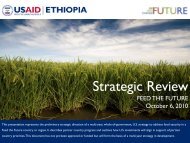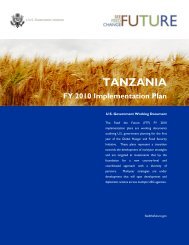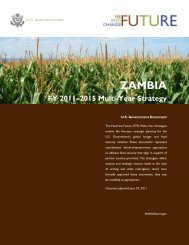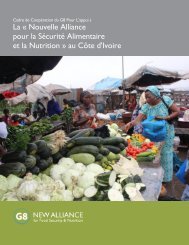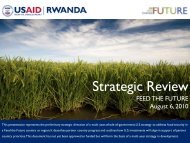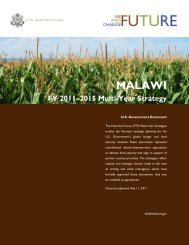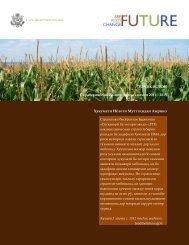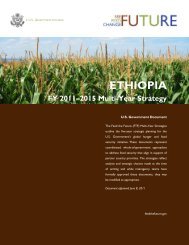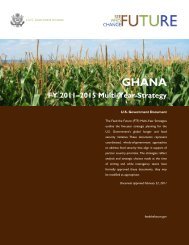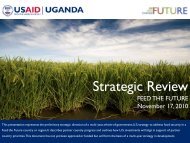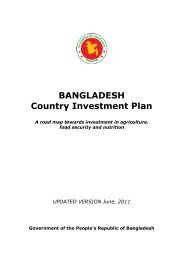Feed the Future Multi-Year Strategy, Senegal, Public
Feed the Future Multi-Year Strategy, Senegal, Public
Feed the Future Multi-Year Strategy, Senegal, Public
You also want an ePaper? Increase the reach of your titles
YUMPU automatically turns print PDFs into web optimized ePapers that Google loves.
ice in West Africa and has achieved irrigated rice yields in <strong>the</strong> SRV well above that of o<strong>the</strong>r countries in<br />
<strong>the</strong> region. However, irrigable land is under-utilized due to lack of investment. During <strong>the</strong> past five<br />
years <strong>the</strong> world market in rice has undergone many structural changes. For example, a recent imported<br />
rice study (USAID/PCE, 20108) found: 1) an increase in Sou<strong>the</strong>rn American market share; 2) a<br />
decreased share for Asian countries; and 3) a new supply from Egypt.<br />
Figure 2. Market Share for Rice Imports by Origin from 2008 to 2010<br />
The FTF strategy supports <strong>the</strong> GOS response to 2008 prices, as written in both <strong>the</strong> Grande Offensive<br />
Agricole pour la Nourriture et l’Abondance (GOANA) and <strong>the</strong> PNAR (Plan National d’Autosuffisance<br />
en Riz). The CIP continues this trend targeting rice.<br />
AfricaRice research 9 shows that rice competiveness is related to non-price characteristics and that<br />
investment in post-harvest quality tailored to consumer demand is <strong>the</strong> first step which needs to be<br />
undertaken in <strong>the</strong> reversal of urban bias toward Asian rice 10 . This research indicates urban consumers<br />
are willing to pay price premiums averaging 45 f cfa/kg for quality SRV rice, relative to imported rice. In<br />
a market snapshot, <strong>the</strong> retailer’s price margin was 10 f cfa/kg for SRV rice compared to 2 f cfa for<br />
imported rice. <strong>Senegal</strong> is one of <strong>the</strong> top ranking countries for rice yield and <strong>the</strong>re has been substantial<br />
investment in <strong>the</strong> sector over <strong>the</strong> last 30 years. Currently, quality is <strong>the</strong> key driver for changing<br />
productivity in <strong>the</strong> rice value chain. As a result of past capacity development activities, some <strong>Senegal</strong>ese<br />
processors with modern equipment are able to produce quality rice by improving drying time and<br />
grinding. Some of this rice is indistinguishable from imported. Ultimately, as <strong>the</strong> SRV increases capacity,<br />
a high-quality local product will be targeted.<br />
Therefore, <strong>the</strong> USG uses an approach focusing on traders, millers and producers linked with formal<br />
contractual arrangements as <strong>the</strong> driver to quality improvement. The strategy focuses on increasing<br />
capacity of <strong>the</strong> seed development system, research and production of breeder foundation seeds with<br />
ISRA and AfricaRice, and certification services for commercial seeds. Fur<strong>the</strong>r, <strong>the</strong> strategy supports rice<br />
production consolidators’ networks to reduce transaction costs and increase quality. Small scale and<br />
7<br />
Etude sur la competitivite du riz de la vallee du fleuve <strong>Senegal</strong> sur les marches nationaux et regionaux.<br />
8<br />
USAID/PCE (2010). Rapport sur l’etude de la distribution du riz importe au <strong>Senegal</strong>.<br />
9<br />
Demont M, Rutsaert P., Ndour M. and Verbeke W. (2010). Reversing Urban Bias in End-Markets:<br />
Competitiveness of <strong>Senegal</strong> River Valley Rice.<br />
10<br />
Matty Demont and Amy C. Rizzotto (2010) Policy Sequencing and <strong>the</strong> Development of Rice Value Chains in<br />
<strong>Senegal</strong><br />
17



